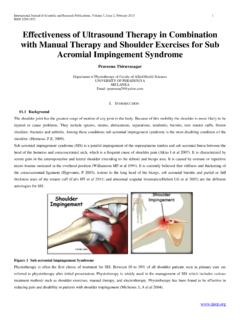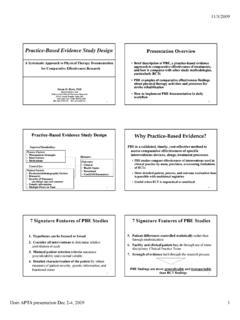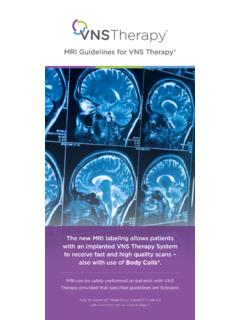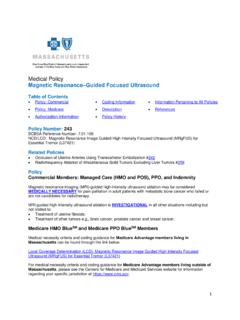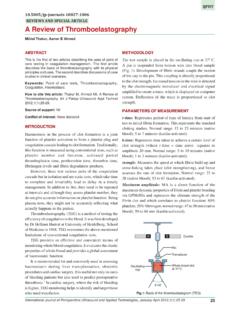Transcription of Therapeutic Ultrasound 4-3 - nycc.edu
1 Chapter 4 Physiological Therapeutics 3 Therapeutic Ultrasound Date Revised 10/8/03 Educational and Patient Care Protocols 1 Chapter 4 -3 Therapeutic Ultrasound PHYSIOLOGIC EFFECTS OF Ultrasound 1. Increased collagen extensibility 5. Increased nerve conduction velocities 2. Increased metabolism of edema and exudates 6. Decreased joint stiffness 3. Increased pain threshold 7. Decreased muscle spasm 4. Releases histamine These changes are the result of the chemical, biologic, mechanical, and thermal effects of the soundwaves.
2 Ultrasound is a deep heating modality. At an intramuscular depth of 3 cm, a 10-minute hot pack treatment yielded an increase of C, whereas at this same depth, 1 MHz Ultrasound has raised muscle temperature nearly 4 C in 10 minutes. At 1 cm below the fat surface, a 4-minute warm whirlpool ( C) raised the temperature C; however, at this same depth, 3 MHz Ultrasound raised the temperature 4 C in 4 minutes. Non-thermal effects occur when pulsed Ultrasound is applied. Non-thermal effects are useful for decreasing edema and promoting cellular repair. INDICATIONS FOR USE 1.
3 Soft tissue injuries 8. Myositis ossificans 2. Chronic connective tissue and joint dysfunction 9. Nerve entrapments 3. Osteoarthritis 10. Plantar warts 4. Periarthritis (non septic) 11. Ganglia 5. Bursitis 12. Chronic sprains / strains 6. Tensosynovitis 13. Muscle spasm 7. Tendonitis, bursitis, capsulitis CONTRAINDICATIONS AND PRECAUTIONS Contraindications 1. Cancerous lesions 6. Metal implants 2. Pregnant uterus 7. Eyes, heart, reproductive organs 3. Over the spinal column / brain 8. Deep vein thrombosis 4.
4 Fractures 9. Tissue under therapy with radiation 5. Growing epiphyseal junction Precautions 1. Bony prominences 2. Decreased sensitivity 3. Decreased circulation Date Revised 10/8/03 Educational and Patient Care Protocols 2 Chapter 4 -3 SAFETY CONSIDERATIONS FOR THE Ultrasound HEAD The crystal within the Ultrasound head will only perform predictably and safely if it is not mishandled by the operator. If the soundhead is dropped, the manufacturer should be called to determine if the crystal has been damaged (possibly changing its output).
5 It is also essential that the Ultrasound intensity NEVER be turned up before the soundhead is against a medium that will conduct the soundwaves. When the intensity is turned up without a transmission couplant, the soundwaves bounce back into the crystal, heating the head and risking the integrity of the crystal. TECHNIQUES OF APPLICATION Treatment area The skin should be clean and dry before applying the coupling gel. The treatment area should be no more than twice the size of sound head. Transmission media (couplant) The higher the water conductive medium, the less the Ultrasound energy is absorbed by the medium and the more energy is available to produce thermal effect.
6 Less efficient mediums heat up, resulting in surface warmth to patient. In order of efficiency: 1. Water 2. Aqueous gel (conducts 96% of sound) 3. Hydro gel, (brand x), 68% of sound conducted 4. Mineral oil 5. Coupling lotion Treatment time Treatment time is generally between 5 and 10 minutes. Never treat over 15 minutes regardless of treatment area. Frequency of treatment Acute conditions may be treated using low intensity or pulsed Ultrasound once or even twice daily for 6 to 8 days until acute symptoms such as pain and swelling subside. In chronic conditions, treatment may be done on alternating days.
7 Ultrasound treatment should continue as long as there is improvement. If no improvement is noted following three or four treatments, Ultrasound should be discontinued, or different parameters ( , duty cycle, frequency) employed. Typically recommended treatment times have ranged between 5 and 10 minutes in Date Revised 10/8/03 Educational and Patient Care Protocols 3 Chapter 4 -3 length. The energy produced with 3 MHz Ultrasound is absorbed three times faster than that produced from 1 MHz Ultrasound . Ultrasound treatments are similar to exercise session in that each session builds on the previous one.
8 For most conditions and whenever possible, daily Ultrasound treatments will provide the most benefits to the patient. Penetration of Ultrasound Depth of penetration is dependent on the frequency of the US machine. The higher the frequency, the more superficial the treatment depth will be. Continuous versus pulsed Ultrasound Continuous This setting is indicated for subacute, chronic conditions with no active inflammation. Soundwaves are emitted continuously throughout the treatment. Because of the amount of friction created in the tissue, heat is created. Pulsed Pulsed Ultrasound is beneficial in acute conditions, inflammatory responses, nerve entrapment and neuromas in scar tissue.
9 Soundwave propagation is intermittent, retaining the mechanical effects of mild cavitation and micro massage without any thermal effects. Methods of Soundwave Transmission Direct Contact- When using the direct technique, the Ultrasound head is put against the skin with only a thin layer of couplant (gel or lotion) in between. Considerations when using this technique are the amount of soft tissue over the bone in that area ( bony areas may be better suited to indirect treatment, described below) and the size of the soundhead (large soundheads may require the indirect technique when treating a small area.)
10 Treatment time: 5 10 minutes Mode of heat transfer: Conversion Penetration: 4 6 cm Application Procedure: Step 1: Apply a generous amount of coupling medium to clean dry skin Step 2: Move transducer in either a circular or stroking pattern Step 3: Turn intensity up to treatment level Step 4: Each circle / stroke should overlap the previous by Step 5: Treatment area limited to 2 times size of transducer Step 6: Slow and deliberate (moving the soundhead approximately 4 cm per second) Step 7: Transducer must stay in contact and in motion to avoid overheating of the transducer and damage to the crystal Date Revised 10/8/03 Educational and Patient Care Protocols 4 Chapter 4 -3 Indirect - When putting the soundhead against the skin is not advisable or possible, the indirect technique may be used.



